Decorate With Fabric to Make Your Home Look Stunning
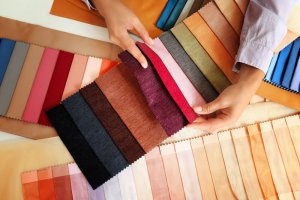
If you want to try to decorate your home with something new, don’t forget to think about using fabric! It brings color and texture, enriching a room with a sense of life and warmth.
All throughout history, natural fabrics have always been a part of home decor. Fabric has the amazing ability to adapt to any atmosphere. It can work in both the more intimate spaces (bedrooms and bathrooms), or common areas like the living room, kitchen, entryway, etc…
Fabric can even change your perception of a room’s architecture, make a piece of furniture look new, or regulate the amount of light that comes into a room.
Decorate your home with fabric: how to choose the material
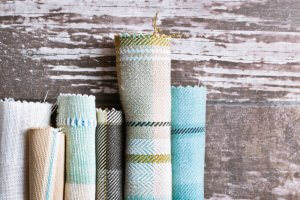
It’s impossible to deny fabric’s value as a decoration. But when you’re trying to pick out a specific material, you do have to keep in mind practical things like washing, maintenance, and durability.
If it’s going to be in frequent use, you should pick out a durable, washable material. It’s better to only use more delicate fabrics in places you won’t be in much contact with. We also suggest using textured fabrics, because they’ll add depth to the room.
If there’s anyone in your home who has asthma or allergies, you should pick out natural fabrics like cotton, because they don’t hold as much dust.
Good combinations
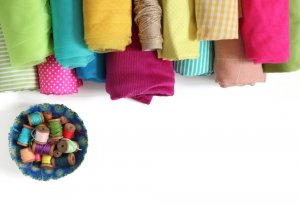
The design and texture of a fabric can completely alter the atmosphere of a room. For example, in small rooms without much light, it can be extremely helpful to use bright, warm colors like orange or subtle patterns.
With big rooms, on the other hand, it’s best to use cold colors (blue, green, purple, etc), which will give the room a sense of freshness. We also recommend patterns with large designs.
If you want to maintain an aesthetic balance, it’s best to make sure that the color scheme and texture of the fabric is in line with the floors, walls, and furniture.
But it’s always best to plan ahead, so ask for samples of the fabrics and materials you want to put together before you do anything. Here’s an example: fabric for the curtains, a different kind for the couch, then wood for the floor and paint on the walls.
The role light plays in decorating with fabric

Before you buy any fabric, make sure you look at it in both natural and artificial light. Different types of lighting can change the tones and texture the fabric takes on, and it might not stand out the way you want it to.
The best way to avoid any unwanted surprises is to put the fabric sample in the part of the house you’re going to use it in. That will give you a chance to see how it reacts to the light in the room. From there, you can decide if it has the effect you want it to.
A style of your own
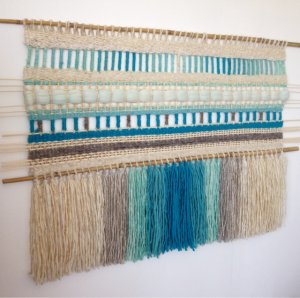
Want to know how to create a sense of personality? When you’re mixing multiple fabrics, you need to keep some things in mind to avoid cluttering the space. It’s always important to have consistency in your colors and patterns.
One thing we like to do is put fabrics in unexpected places. Besides using fabric to decorate windows, tables, and couches, you can also use it to do up a dresser or a desk.
Fabrics can also bring a lot of warmth to a room when hung on the walls. You can use them in most rooms, except for the kitchen or bathroom. It’s best to avoid them in those rooms because of the dirt in a kitchen and the moisture in a bathroom.
Another great thing about fabric is that it can work as both sound and temperature insulation. This makes it especially good for the walls of living rooms and bedrooms. The best fabrics to use here are ones with “high drape,” like cotton.
Decorate with fabric: different types
The weight of a fabric, along with how see-through or opaque it is, will determine how you use it in your home. Some are best as a cover, others as upholstery, and others as bedclothes, just to give a few examples.
Heavy fabrics

Heavy fabrics give off a sense of solidity. But they can also be overpowering, especially if you use them in warm rooms. They work really well for upholstery, large curtains, and pillowcases. Velvet, wool, and chenille are all good examples.
Decorate with light fabric
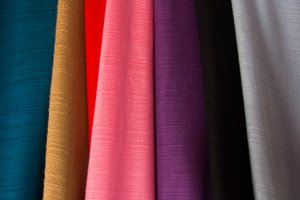
The lighter a piece of fabric is, and the more delicate and see-through it is, the less presence it will seem to have in a room. That makes it great for curtains, simple upholstery, bedclothes, and tablecloths. It’s easy to handle and clean. Silk, cotton, linen, and cashmere are all good examples.
See-through vs. opaque fabrics
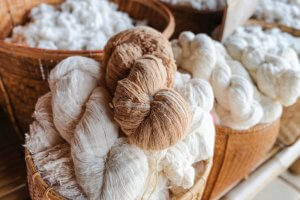
See-through fabrics like muslin, tulle, and chiffon are great for small curtains. They’re generally not easy to modify, but easy to bundle up. Thicker, opaque fabrics like satin and calico are better for upholstery and coverings.
If you want to try to decorate your home with something new, don’t forget to think about using fabric! It brings color and texture, enriching a room with a sense of life and warmth.
All throughout history, natural fabrics have always been a part of home decor. Fabric has the amazing ability to adapt to any atmosphere. It can work in both the more intimate spaces (bedrooms and bathrooms), or common areas like the living room, kitchen, entryway, etc…
Fabric can even change your perception of a room’s architecture, make a piece of furniture look new, or regulate the amount of light that comes into a room.
Decorate your home with fabric: how to choose the material

It’s impossible to deny fabric’s value as a decoration. But when you’re trying to pick out a specific material, you do have to keep in mind practical things like washing, maintenance, and durability.
If it’s going to be in frequent use, you should pick out a durable, washable material. It’s better to only use more delicate fabrics in places you won’t be in much contact with. We also suggest using textured fabrics, because they’ll add depth to the room.
If there’s anyone in your home who has asthma or allergies, you should pick out natural fabrics like cotton, because they don’t hold as much dust.
Good combinations

The design and texture of a fabric can completely alter the atmosphere of a room. For example, in small rooms without much light, it can be extremely helpful to use bright, warm colors like orange or subtle patterns.
With big rooms, on the other hand, it’s best to use cold colors (blue, green, purple, etc), which will give the room a sense of freshness. We also recommend patterns with large designs.
If you want to maintain an aesthetic balance, it’s best to make sure that the color scheme and texture of the fabric is in line with the floors, walls, and furniture.
But it’s always best to plan ahead, so ask for samples of the fabrics and materials you want to put together before you do anything. Here’s an example: fabric for the curtains, a different kind for the couch, then wood for the floor and paint on the walls.
The role light plays in decorating with fabric

Before you buy any fabric, make sure you look at it in both natural and artificial light. Different types of lighting can change the tones and texture the fabric takes on, and it might not stand out the way you want it to.
The best way to avoid any unwanted surprises is to put the fabric sample in the part of the house you’re going to use it in. That will give you a chance to see how it reacts to the light in the room. From there, you can decide if it has the effect you want it to.
A style of your own

Want to know how to create a sense of personality? When you’re mixing multiple fabrics, you need to keep some things in mind to avoid cluttering the space. It’s always important to have consistency in your colors and patterns.
One thing we like to do is put fabrics in unexpected places. Besides using fabric to decorate windows, tables, and couches, you can also use it to do up a dresser or a desk.
Fabrics can also bring a lot of warmth to a room when hung on the walls. You can use them in most rooms, except for the kitchen or bathroom. It’s best to avoid them in those rooms because of the dirt in a kitchen and the moisture in a bathroom.
Another great thing about fabric is that it can work as both sound and temperature insulation. This makes it especially good for the walls of living rooms and bedrooms. The best fabrics to use here are ones with “high drape,” like cotton.
Decorate with fabric: different types
The weight of a fabric, along with how see-through or opaque it is, will determine how you use it in your home. Some are best as a cover, others as upholstery, and others as bedclothes, just to give a few examples.
Heavy fabrics

Heavy fabrics give off a sense of solidity. But they can also be overpowering, especially if you use them in warm rooms. They work really well for upholstery, large curtains, and pillowcases. Velvet, wool, and chenille are all good examples.
Decorate with light fabric

The lighter a piece of fabric is, and the more delicate and see-through it is, the less presence it will seem to have in a room. That makes it great for curtains, simple upholstery, bedclothes, and tablecloths. It’s easy to handle and clean. Silk, cotton, linen, and cashmere are all good examples.
See-through vs. opaque fabrics

See-through fabrics like muslin, tulle, and chiffon are great for small curtains. They’re generally not easy to modify, but easy to bundle up. Thicker, opaque fabrics like satin and calico are better for upholstery and coverings.







